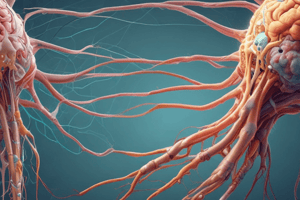Podcast
Questions and Answers
What is the reason why we always see the same face of the moon?
What is the reason why we always see the same face of the moon?
- The Earth's gravity generates a small tidal bulge on the Moon's surface
- The Moon spins on its axis at just the right rate to keep the same side visible (correct)
- The Moon moves along its orbit around the Earth
- The Moon's orbit is oriented at about 5.2 degrees to the Earth's orbital plane
What causes the tidal forces responsible for the Moon's synchronous rotation?
What causes the tidal forces responsible for the Moon's synchronous rotation?
- The Earth's gravitational pull generating a small tidal bulge on the Moon's surface
- Friction generated by the Moon's spin
- The Moon's orbit around the Earth
- Gravitational pull of the two bodies (correct)
What effect does the Moon's gravity have on Earth?
What effect does the Moon's gravity have on Earth?
- Seasonal changes
- Atmospheric pressure
- Plate tectonics
- Tidal cycles (correct)
Why do we actually see 59% of the Moon's surface over the course of the month?
Why do we actually see 59% of the Moon's surface over the course of the month?
What causes tides on Earth?
What causes tides on Earth?
What is the average distance of the Moon from Earth?
What is the average distance of the Moon from Earth?
What creates the phases of the Moon?
What creates the phases of the Moon?
What is the cause of lunar eclipses?
What is the cause of lunar eclipses?
When does a solar eclipse occur?
When does a solar eclipse occur?
What was the name of the first man to walk on the Moon?
What was the name of the first man to walk on the Moon?
How many Apollo missions occurred between 1969 and 1972?
How many Apollo missions occurred between 1969 and 1972?
What is the goal of NASA's Artemis II mission?
What is the goal of NASA's Artemis II mission?
What is the speed at which the Moon moves in its orbit?
What is the speed at which the Moon moves in its orbit?
What is the term used for the varying visibility of the Moon's lit surface?
What is the term used for the varying visibility of the Moon's lit surface?
What was the primary influence of lunar months on calendars?
What was the primary influence of lunar months on calendars?
What occurs when the Moon passes directly between the Earth and the Sun?
What occurs when the Moon passes directly between the Earth and the Sun?
Flashcards are hidden until you start studying
Study Notes
The Moon and its Influence
- Some aspects of animal life are influenced by the lunar cycle, such as the hatching of eggs and bird migrations.
- The Moon's gravity causes tides, with high tide occurring every 12 hours and 25 minutes and low tide on the other sides of the Earth.
- The Moon is 384,000 km away from Earth and moves in its orbit at a speed of 1 km/s.
- The Moon is visible due to reflected sunlight, and its different visible amounts create phases, completing a cycle in 29.5 days.
- Lunar months were once the basis of calendars, but they fell out of sync with the seasons.
- Moonlight is reflected sunlight, and the varying visibility of the Moon's lit surface is called "phases."
- The Moon rises at the same time as the Sun during a new moon, and its visible part waxes or grows every night.
- The Moon passes through phases known as the crescent Moon, quarter Moon, and gibbous Moon, with the cycle completing at the new phase.
- Lunar eclipses occur when the Moon moves into Earth's shadow, with about 2-3 per year at different locations.
- An eclipse occurs when the Moon or Earth passes through the other's shadow, and solar eclipses occur during a new Moon.
- A lunar eclipse happens when the Moon passes behind the Earth, and about 35% of lunar eclipses in a year are total lunar eclipses.
- Solar eclipses occur when the Moon passes directly between the Earth and the Sun, and their frequency and occurrence on the ground are limited.
Exploring the Moon
- Probes were sent to the Moon in the 1950s and 1960s, and the first man on the Moon was Neil Armstrong in 1969.
- Six Apollo missions occurred between 1969 and 1972, bringing back 382 kg (842 lbs) of rocks, and 12 Americans have walked on the Moon.
- The Artemis II mission is scheduled for November 2024, with a four-person crew circling the Moon as part of NASA's plan to return astronauts to the Moon in 2025.
Studying That Suits You
Use AI to generate personalized quizzes and flashcards to suit your learning preferences.




